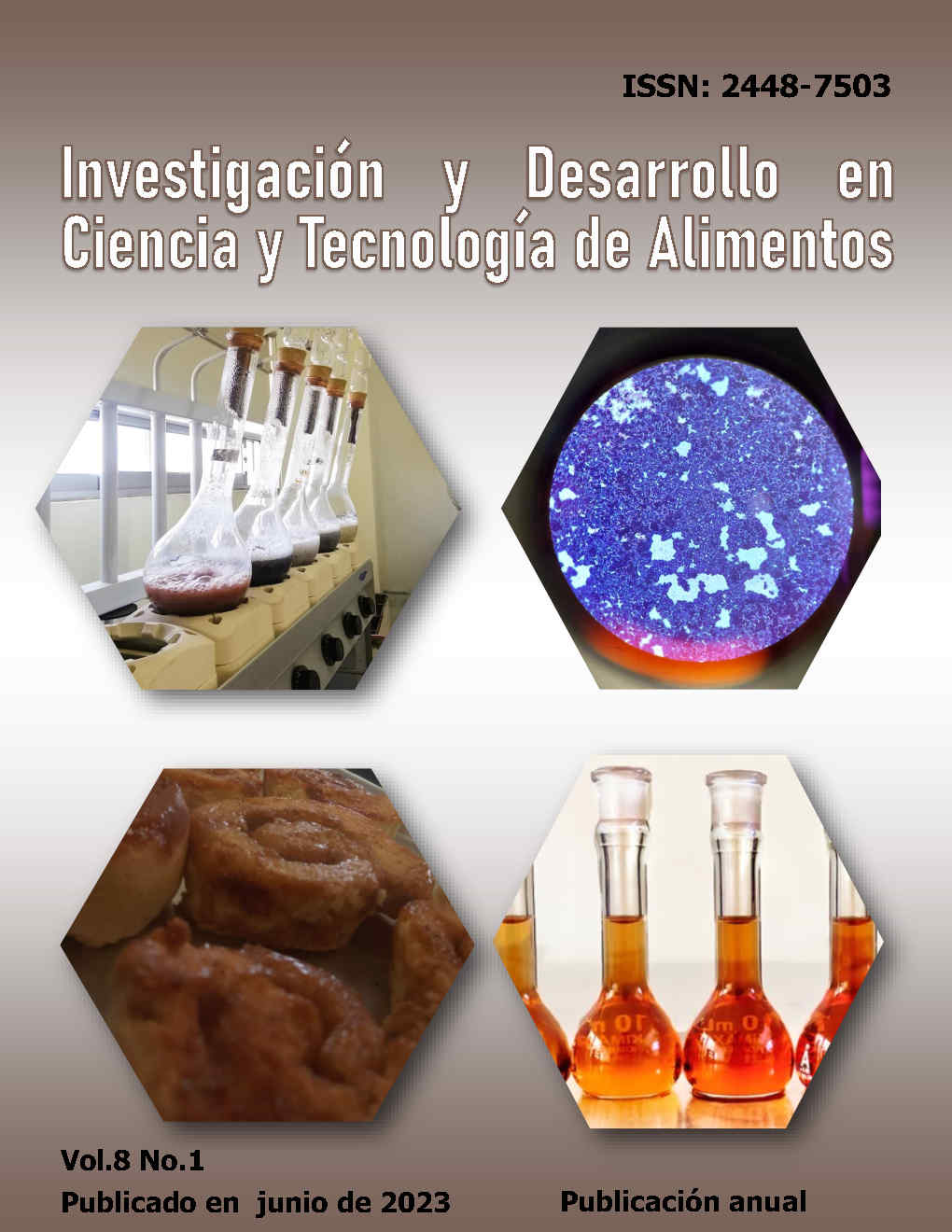Optimización para la extracción de ficocianina de la cianobacteria Spirulina maxima
DOI:
https://doi.org/10.29105/idcyta.v8i1.107Keywords:
Spirulina, phycocyanin, extraction, temperatue, response surfaceAbstract
The use of Spirulina maxima in the formulation of functional foods has risen in recent years due to its beneficial properties in human health. Moreover, the use of phycocyanin from S. maxima is of interest because of its anti-inflammatory, antioxidant and anticarcinogenic activities, acting directly in reducing oxidative stress, apoptosis and inflammatory processes in live models. Nonetheless, one of the problems of its application in food is the optimization of extraction by maximizing concentration and stability, since current methodologies are time-consuming and do not yield enough concentration, making the process costly and demanding. In this work, an extraction method based in phosphate buffer was proposed, due to its simplicity, with the goal of optimizing process parameters (temperature, pH, agitation, solvent ratio and time) in order to maximize extracted phycocyanin concentration, using response surface methodology. Subsequently, the optimal conditions were validated in order to confirm consistency between predicted data and real concentrations.
Downloads
References
IPSOS. (2018). Nuevas tendencias alimentarias a nivel mundial. Obtenido de: www.ipsos.com
Nielsen. (2016). 8 de cada 10 mexicanos afirma seguir algún tipo de dieta restrictiva. Obtenido de: www.nielsen.com
Grand View Research. (2019). Functional foods market size, share and trend analysis report. Obtenido de: www.grandviewresearch.com
Morançais, M., Mouget, J.-L., & Dumay, J. (2018). Proteins and Pigments. Microalgae in Health and Disease Prevention, 145–175. doi:10.1016/b978-0-12-811405-6.00007-4 DOI: https://doi.org/10.1016/B978-0-12-811405-6.00007-4
Pez Jaeschke, D., Rocha Teixeira, I., Damasceno Ferreira Marczak, L., & Domeneghini Mercali, G. (2021). Phycocyanin from Spirulina: A review of extraction methods and stability. Food Research International, 143, 110314.
Jaeschke, D., Rocha, I., Damasceno, L. & Domeneghini, G. (2021). Phycocyanin from Spirulina: A review of extraction methods and stability. Food Research International, 143(2021), 110314. DOI: https://doi.org/10.1016/j.foodres.2021.110314
Mysliwa, B., Solymosi, K. (2017). Phycobilins and phycobiliproteins used in food industry and medicine. Mini-reviews in Medicinal Chemistry, 17:13(2017), 1173-1193. DOI: https://doi.org/10.2174/1389557516666161004161411
Li, Y., Zhang, Z., Paciulli, M. & Abbaspourrad, A. (2020). Extraction of phycocyanin – A natural blue colorant from dried spirulina biomass: Influence on processing parameters and extraction techniques. Journal of Food Science, 00(2020), 0. DOI: https://doi.org/10.1111/1750-3841.14842
Wu, H., Wang, G., Xiang, W., Li, T. & Hui, H. (2016). Stability and antioxidant activity of food-grade phycocyanin isolated from Spirulina platensis. International Journal of Food Properties, 19(2016), 2349-2362. DOI: https://doi.org/10.1080/10942912.2015.1038564
Zhou, Z., Liu, L., Chen, X. Factors that affect antioxidant activity of C-phycocyanins from Spirulina platensis. Journal of Food Biochemistry. 29(3), 313-322. DOI: https://doi.org/10.1111/j.1745-4514.2005.00035.x
Colla, L., Bertol, C., Ferreria, D., Bavaresco, J., Costa, J., Bertolin, T. Thermal and photo-stability of the antioxidant potential of Spirulina platensis powder. Brazilian Journal of Biology. 77(2), 332-339. DOI: https://doi.org/10.1590/1519-6984.14315
Su, C., Liu, C., Yang, P., Syu, K., Chiuh, C. (2014). Solid-liquid extraction of phycocyanin from Spirulina platensis: Kinetic modeling of influential factors. Separation and Purification Technology, 123, 64-68. DOI: https://doi.org/10.1016/j.seppur.2013.12.026
Downloads
Published
How to Cite
Issue
Section
License
Copyright (c) 2023 Carlos Sada-Borrego , Celestino García-Gómez, Claudio Guajardo-Barbosa , Julia Márquez-Reyes, Juan Nápoles-Armenta, Julio Beltrán-Rocha

This work is licensed under a Creative Commons Attribution 4.0 International License.
Los autores/as que publiquen en esta revista aceptan las siguientes condiciones:
a. Los autores/as conservarán sus derechos de autor y garantizarán a la revista el derecho de primera publicación de su obra, el cual estará simultáneamente sujeto a la Licencia Creative Commons Atribución 4.0 Internacional. que permite a terceros compartir la obra siempre que se indique su autor y su primera publicación esta revista.
b. Los autores/as pueden realizar otros acuerdos contractuales independientes y adicionales para la distribución no exclusiva de la versión del artículo publicado en esta revista (p. ej., incluirlo en un repositorio institucional o publicarlo en un libro) siempre que indiquen claramente que el trabajo se publicó por primera vez en esta revista.
c. Se permite y recomienda a los autores/as a publicar su trabajo en Internet (por ejemplo en páginas institucionales o personales) posterior al proceso de revisión y publicación, ya que puede conducir a intercambios productivos y a una mayor y más rápida difusión del trabajo publicado.





